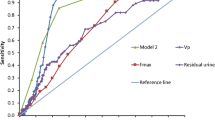Abstract
Introduction and hypothesis
Pre-procedure urinalysis may add unnecessary cost and inconvenience for patients undergoing urodynamics. The hypothesis of this study was that urinalysis would perform poorly when predicting complications following urodynamics.
Methods
Case–control study of women aged 18–89 undergoing urodynamics from 01 January2008 to 31 December 2017 at two tertiary medical centers. Data collected included patient demographics, past medical history, lower urinary tract symptoms, urodynamics indication, urodynamics results, urinalysis result, antibiotic administration, and adverse events within 30 days. Wilcoxon rank-sum test was used to compare those with and without an adverse event. Logistic regression was performed using statistically significant variables on pairwise analysis.
Results
A total of 601 patients met the criteria; 11 of these experienced an adverse event, of which all were a urinary tract infection. There were no differences in the frequency of adverse events based on any urinalysis result, regardless of whether the patient received antibiotics. On pairwise analysis, variables associated with a higher frequency of adverse events were higher parity (3.5 (2–5) vs 2 (2, 3), p=0.038) and complaint of suprapubic pain (1 (9.1%) vs 4 (0.7%), p=0.002). On logistic regression, significant variables included increasing age (adjusted odds ratio [aOR] 1.03 per year (95% CI 1.03–4.06); p=0.002), any prolapse (aOR 6.45 (95% CI 3.60–11.54); p<0.001), pelvic organ prolapse as the indication for urodynamics (aOR 7.27 (95% CI 2.60–20.36); p<0.001), and a diagnosis of stress urinary incontinence (4.98 (95% CI 1.95–12.67); p<0.001).
Conclusion
The frequency of adverse events after urodynamics is low, and urinalysis in asymptomatic patients does not seem to be useful in predicting morbidity.
Similar content being viewed by others
References
Cameron AP, Campeau L, Brucker BM, et al. Best practice policy statement on urodynamic antibiotic prophylaxis in the non-index patient. Neurourol Urodyn. 2017;36(4):915–26. https://doi.org/10.1002/nau.23253.
Bent S, Nallamothu BK, Simel DL, Fihn SD, Saint S. Does this woman have an acute uncomplicated urinary tract infection? JAMA. 2002;287(20):2701–10. https://doi.org/10.1001/jama.287.20.2701.
Chu CM, Lowder JL. Diagnosis and treatment of urinary tract infections across age groups. Am J Obstet Gynecol. 2018;219(1):40–51. https://doi.org/10.1016/j.ajog.2017.12.231.
Chung Y, Ko D-H, Hyun J, Kim HS, Park M-J, Shin DH. Establishing cut-offs for urine erythrocyte and leukocyte dipstick tests. Scand J Clin Lab Invest. 2018;78(4):301–4. https://doi.org/10.1080/00365513.2018.1463559.
Flokas ME, Andreatos N, Alevizakos M, Kalbasi A, Onur P, Mylonakis E. Inappropriate management of asymptomatic patients with positive urine cultures: a systematic review and meta-analysis. Open Forum Infect Dis. 2017;4(4):ofx207. https://doi.org/10.1093/ofid/ofx207.
Nóbrega MM, Auge AP, de Toledo LG, da Silva CS, Frade AB, Salles MJ. Bacteriuria and urinary tract infection after female urodynamic studies: risk factors and microbiological analysis. Am J Infect Control. 2015;43(10):1035–9. https://doi.org/10.1016/j.ajic.2015.05.031.
Dass AK, Lo TS, Khanuengkitkong S, Tan YL. Bacteriuria and safety of female urodynamic studies. Int Urogynecol J. 2013;24(4):677–82. https://doi.org/10.1007/s00192-012-1910-0.
Bengtsson C, Bengtsson U, Björkelund C, Lincoln K, Sigurdsson JA. Bacteriuria in a population sample of women: 24-year follow-up study. Results from the prospective population-based study of women in Gothenburg, Sweden. Scand J Urol Nephrol. 1998;32(4):284–9. https://doi.org/10.1080/003655998750015467.
Zalmanovici Trestioreanu A, Lador A, Sauerbrun-Cutler MT, Leibovici L. Antibiotics for asymptomatic bacteriuria. Cochrane Database Syst Rev. 2015;4(4):CD009534. https://doi.org/10.1002/14651858.cd009534.pub2.
Snow-Lisy DC, Halline C, Johnson EK, Diaz-Saldano D, Meyer T, Yerkes EB. Reassessing the utility of routine urine culture with urodynamics: UTI incidence and risk factors. J Pediatr Urol. 2017;13(4):372.e1–8. https://doi.org/10.1016/j.jpurol.2017.05.013.
Tsai SW, Kung FT, Chuang FC, Ou YC, Wu CJ, Huang KH. Evaluation of the relationship between urodynamic examination and urinary tract infection based on urinalysis results. Taiwan J Obstet Gynecol. 2013;52(4):493–7. https://doi.org/10.1016/j.tjog.2013.10.007.
Monane M, Gurwitz JH, Lipsitz LA, Glynn RJ, Choodnovskiy I, Avorn J. Epidemiologic and diagnostic aspects of bacteriuria: a longitudinal study in older women. J Am Geriatr Soc. 1995;43(6):618–22. https://doi.org/10.1111/j.1532-5415.1995.tb07194.x.
Bombieri L, Dance DA, Rienhardt GW, Waterfield A, Freeman RM. Urinary tract infection after urodynamic studies in women: incidence and natural history. BJU Int. 1999;83(4):392–5. https://doi.org/10.1046/j.1464-410x.1999.00924.x.
Hirakauva E, Bianchi-Ferraro A, Zucchi E, et al. Incidence of bacteriuria after urodynamic study with or without antibiotic prophylaxis in women with urinary incontinence. Rev Bras Ginecol Obstet. 2017;39(10):534–40. https://doi.org/10.1055/s-0037-1604066.
Moore KH, Simons A, Mukerjee C, Lynch W. The relative incidence of detrusor instability and bacterial cystitis detected on the urodynamic-test day. BJU Int. 2000;85(7):786–92. https://doi.org/10.1046/j.1464-410x.2000.00619.x.
Walsh CA, Siddins A, Parkin K, Mukerjee C, Moore KH. Prevalence of "low-count" bacteriuria in female urinary incontinence versus continent female controls: a cross-sectional study. Int Urogynecol J. 2011;22(10):1267–72. https://doi.org/10.1007/s00192-011-1506-0.
Okorocha I, Cumming G, Gould I. Female urodynamics and lower urinary tract infection. BJU Int. 2002;89(9):863–7. https://doi.org/10.1046/j.1464-410x.2002.02770.x.
Winters JC, Dmochowski RR, Goldman HB, et al. Urodynamic studies in adults: AUA/SUFU guideline. J Urol. 2012;188(6 Suppl):2464–72. https://doi.org/10.1016/j.juro.2012.09.081.
Haider G, Zehra N, Munir AA, Haider A. Risk factors of urinary tract infection in pregnancy. J Pak Med Assoc. 2010;60(3):213–6.
Enayat K, Fariba F, Bahram N. Asymptomatic bacteriuria among pregnant women referred to outpatient clinics in Sanandaj, Iran. Int Braz J Urol. 2008;34(6):699–707. https://doi.org/10.1590/s1677-55382008000600004.
Kline KA, Schwartz DJ, Gilbert NM, Lewis AL. Impact of host age and parity on susceptibility to severe urinary tract infection in a murine model. PLoS One. 2014;9(5):e97798. https://doi.org/10.1371/journal.pone.0097798.
Author information
Authors and Affiliations
Contributions
K. Roberts: data collection or management, data analysis, manuscript writing/editing; A. Alfahmy: data collection or management, manuscript writing/editing; D. Mitchell: manuscript writing/editing; S. Kamumbu: data collection or management, manuscript writing/editing; A. Sebikali-Potts: data collection or management, manuscript writing/editing; D. Sheyn: protocol/project development, data analysis, manuscript writing/editing.
Corresponding author
Ethics declarations
Conflicts of interest
The authors declare that they have no conflicts of interest. However, D. Sheyn has received funding for support from Renalis and the Eunice Kennedy Shriver National Institute of Child Health and Human Development. None of the other authors has no disclosures or additional sources of funding.
Additional information
Publisher’s note
Springer Nature remains neutral with regard to jurisdictional claims in published maps and institutional affiliations.
Rights and permissions
About this article
Cite this article
Roberts, K., Alfahmy, A., Mitchell, D. et al. Dipstick urinalysis does not predict post-urodynamic study morbidity. Int Urogynecol J 34, 897–904 (2023). https://doi.org/10.1007/s00192-022-05276-5
Received:
Accepted:
Published:
Issue Date:
DOI: https://doi.org/10.1007/s00192-022-05276-5



